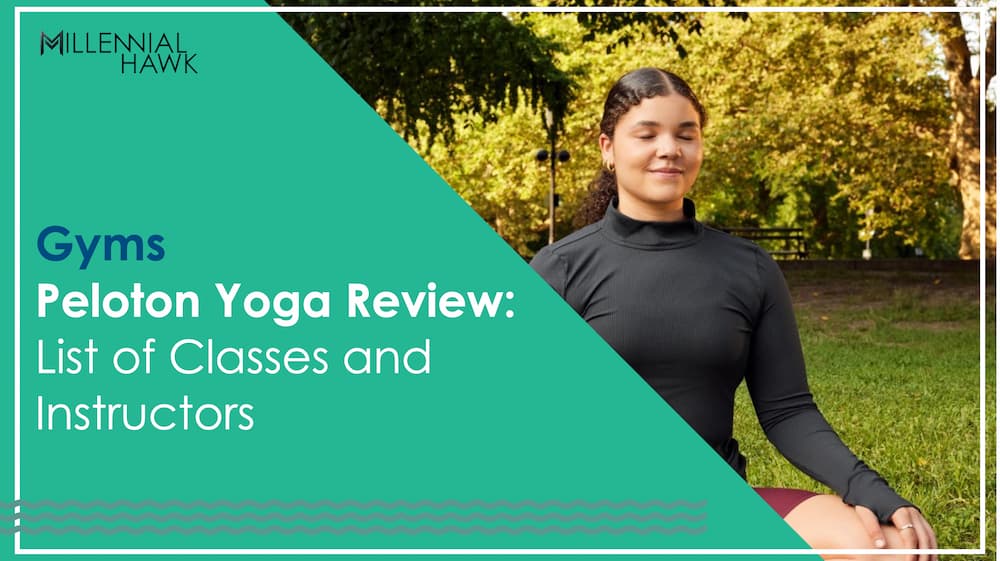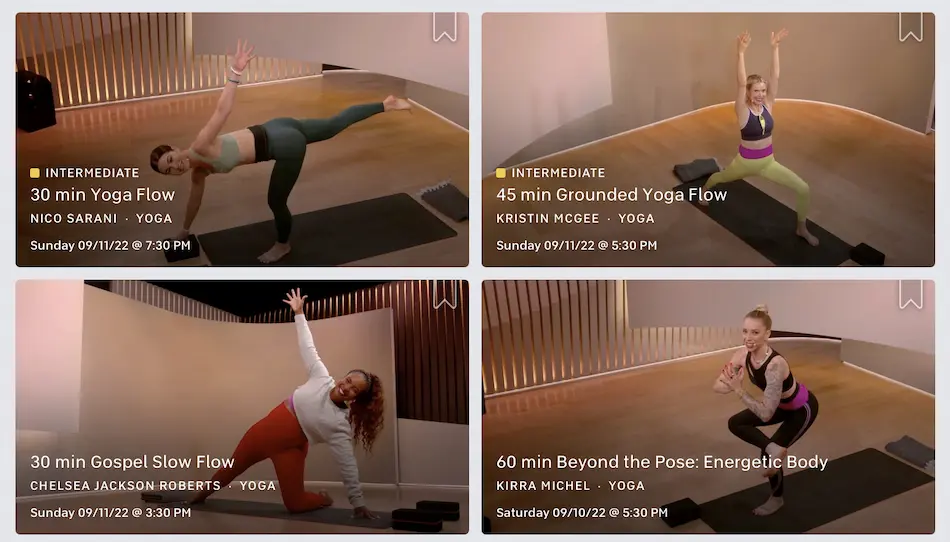
Peloton Yoga refers to a wide range of classes, from beginner tutorials to advanced poses, designed to enhance recovery, improve athleticism, and cater to various skill levels. A subscription to the Peloton app grants you access to 10 categories and over 5,000 different types of Peloton yoga classes, ranging from Peloton evening yoga to chair yoga, making it a cost-effective and versatile option for integrating yoga into your fitness routine.
So, do I need a Peloton membership for yoga classes? Yes, although Peloton does offer some free yoga classes, these are limited in number. To access a wider range of classes and programs, an active membership is required.
Each Peloton yoga class is unique, with most requiring props such as blocks, blankets, straps, and, of course, a yoga mat. The Peloton yoga program, which features 13 different instructors including Aditi Shah, Anna Greenberg, Denis Morton, and others, ranks as the third most popular class category. However, when seeking the best Peloton yoga instructor, Ross Rayburn stands out.
What is Peloton Yoga?
Peloton Yoga is a comprehensive collection of live and on-demand classes designed to help individuals achieve their fitness goals. Rooted in the ancient practice originating in India, Peloton Yoga encompasses a wide range of physical, mental, and spiritual techniques, emphasizing the unification of mind and body. The program offers diverse class types, from Flow to Yoga Conditioning, allowing participants to enhance strength, flexibility, and overall well-being while embracing the essence of energy and union that yoga represents.
The purpose of Peloton Yoga is to help individuals build strength, enhance awareness, and promote harmony in both their mind and body, all while offering a variety of class types to cater to different preferences and fitness goals. Whether you’re seeking balance, flexibility, or a sense of unity, Peloton Yoga provides a range of classes to help you achieve these objectives while moving energy together in unison.
How does Peloton Yoga work?
Peloton Yoga can contribute to weight loss by enhancing overall fitness, although it may not be the primary driver. While daily yoga sessions can burn some calories, its main role in weight management lies in other aspects. Yoga improves mobility, reduces pain, and encourages a healthier lifestyle, indirectly supporting weight loss by addressing factors like emotional eating.
For stress reduction, Peloton Yoga is highly effective due to its focus on relaxation. It promotes mental and physical relaxation, which is the natural antidote to stress. The practice not only alleviates tension in the body, particularly in areas like the hips and shoulders, but it also encourages mindfulness. This mindfulness helps combat stress eating habits and fosters a sense of calm and balance in both the body and mind.

What are the Advantages of Peloton Yoga Classes?
The following list outlines the benefits of Peloton yoga classes.
- Saves Time: With Peloton vinyasa yoga, you can eliminate the need for commuting, gym showers, and class schedules, allowing you to practice whenever and wherever you like. Additionally, Peloton Yoga offers the flexibility to customize the class duration and intensity to suit your fitness level and preferences, making it a versatile and convenient option.
- Provides Full Body Workout: Peloton classes feature poses that challenge both the upper and lower body, complementing your fitness program. Whether training for events or aiming to lose weight, Peloton Yoga offers classes to build full-body strength and enhance your workout routine.
- Reduces Intimidation: If you’ve avoided yoga studios thinking it’s just for women, think again. Peloton yoga is for everyone, and it’s a comfortable place to start your practice.
- Improves Core Strength: Yoga isn’t your typical abs workout, but it still challenges core strength and improves flexibility, posture, balance, and stability. It’s a valuable addition for runners and cyclists to target “weak spots” and prevent lower back or hip issues.
- Improves Foot Strength: Peloton Yoga is done barefoot, which strengthens foot muscles and promotes overall health. It can also provide a grounded, energizing, and calming experience, offering benefits like improved toe flexibility and potential headache relief.
- Helps Counteract Bad Posture: Sitting for extended periods can cause muscle tightness. Short yoga sessions counteract this, improving form in cycling, running, or weight training.
- Improves Mental Strength: Mental strength is crucial for long-term sports goals like weight loss or improved performance. On-demand yoga classes offer consistency and mental flexibility, fostering humility and appreciation for small achievements.
- Improves flexibility: Improved flexibility, especially in the hamstrings and lower back, is crucial for long-term health. Frequent, short yoga sessions can help restore range of motion and enhance muscle suppleness, benefiting swimmers, runners, cyclists, and desk-bound individuals.
What are the Drawbacks of Peloton Yoga Classes?
The drawbacks of Peloton Yoga Classes include the lack of personal touch and adjustments that you would get in a studio, a predominance of basic classes not suited for advanced yogis, and they may not be ideal for individuals recovering from surgery.
- Limited Instructor Interaction: Without in-person guidance, adjustments and personalized feedback are not possible.
- Basic Level Focus: Advanced yogis might find the classes insufficiently challenging.
- Post-Surgery Limitations: The classes might not cater to specific rehabilitation needs post-surgery.
- Homogeneous Routines: Limited variety in yoga styles and sequences compared to specialized yoga studios.
- Space and Environment: Home settings may not replicate the calming, dedicated space of a yoga studio.
Who is the Peloton Yoga Program suitable for?
Peloton Yoga program is suitable for a wide range of individuals, including runners, endurance athletes seeking better recovery and muscle soreness relief, people with lower back pain looking to alleviate discomfort with step-by-step instructions, office workers aiming to improve flexibility without the intimidation of traditional yoga studios, and advanced yogis pursuing challenging milestones like mastering advanced power yoga poses. On the contrary, this class may not be suitable for individuals with certain medical conditions or physical limitations that prevent them from safely participating in yoga exercises.
What are the different types of Peloton Yoga Classes?
Peloton offers ten types of yoga classes, each catering to different preferences and fitness levels.
- Peloton Flow Yoga: These classes focus on fluid movements and transitions between poses. They are suitable for both beginners and intermediate practitioners and offer sessions ranging from 10 to 60 minutes.
- Peloton Focus Flow Yoga: Peloton’s Focus Flow yoga classes come in various durations, ranging from 10 to 45 minutes. For example, you can find a 10-minute session for hamstrings or a 45-minute class focused on arm balances. These classes cater to both beginners and intermediates, offering flexibility in your practice schedule.
- Peloton Slow Flow Yoga: Slow Flow classes prioritize mindfulness and deep stretching to enhance flexibility. They come in convenient 10 to 30-minute sessions, like Peloton’s morning and evening yoga options.
- Peloton Power Yoga: Power yoga classes offer a more intense and challenging workout, lasting around 20 to 30 minutes. They are designed to help you build strength and endurance, and you can find them under names like Peloton Yoga Conditioning or Power Flow.
- Peloton Restoration Yoga: Restorative classes are aimed at relaxation and stress relief. They include restorative poses and are typically 20 minutes long.
- Peloton Theme Yoga: Theme-based classes incorporate various themes such as R&B music or holiday themes, adding a unique touch to the yoga experience. These sessions are 30 minutes in duration.
- Peloton Yoga Anywhere: These classes are designed to be done anywhere, including chair yoga and standing yoga. They offer shorter durations, ranging from 5 to 15 minutes.
- Peloton Yoga Basics: For beginners, Peloton offers basic classes to help establish a strong foundation. These sessions are 5 to 10 minutes long and focus on fundamental poses.
- Peloton Family & Pre/Postnatal Yoga: These classes cater to families and expectant or new mothers, providing options for bonding and gentle yoga.
- Beyond the Pose: Beyond the Pose classes explore deeper aspects of yoga practice, such as community and energetic bodywork, in sessions lasting 20 to 60 minutes.
What are the best Peloton Yoga Classes?
The best Peloton yoga classes can vary depending on your goals and preferences. For weight loss, consider Peloton’s 60-minute Power Flow classes, which provide an intense workout. Additionally, the 30-minute Yoga Conditioning: Lower Body class is excellent for targeting weight loss. Finally, the 20-minute Morning Power Flow offers a dynamic session to boost metabolism.
To alleviate back pain, Peloton offers a range of options. The 20-minute Focus Flow: Healthy Back class is specifically designed for this purpose. You can also try the 10-minute Focus Flow: Lower Body and 20-minute Restorative classes, both of which can provide relief from back discomfort. The best Peloton yoga for beginners is Peloton Family Yoga because it offers a gentle introduction to yoga in a fun, relaxed setting, making it ideal for beginners to learn basic poses and techniques at a comfortable pace.
How to sign up for a Peloton Yoga in-person class?
To sign up for a Peloton Yoga in-person class, follow these steps.
- Visit the Peloton Website or App: Access the official Peloton website or open their mobile app.
- Navigate to the In-Person Classes Section: Locate the section for studio classes, which you’ll find under a studio or location tab, and choose either New York or London, noting that yoga classes are offered three times a week in New York and twice a week in London.
- Select Yoga Class Category: From the list of workout types, choose ‘Yoga’ to view all upcoming yoga classes in the selected location.
- Choose Your Class: Browse the yoga classes, considering the schedule, and select one based on your preferred time, date, and instructor.
- Register for the Class: Complete the registration process, which may involve providing personal information and payment details, to secure your spot in the class.
What are the Peloton Yoga Programs Available?
In addition to single workouts, the Peloton also has 6 yoga programs that focus on a specific long-term goal.
- Beginner Yoga: Peloton Beginner Yoga is a 3-week program designed for those new to yoga, offering a structured and comprehensive introduction to the practice. Led by instructors Aditi Shah, Anna Greenberg, and Kristin McGee, this program includes 22 classes, with a daily commitment ranging from 10 to 30 minutes. It covers foundational aspects of yoga, including movement, class structure, and practice, making it an ideal starting point for beginners looking to explore yoga and its application beyond the mat.
- A Self-Care Retreat: The Peloton A Self-Care Retreat Yoga Program is a curated program designed to enhance your self-care journey through yoga and meditation. It consists of a recommended schedule for each week, including a variety of classes led by instructor Anna Greenberg. This program encourages you to prioritize your well-being by following the prescribed schedule, which combines yoga, meditation, and reflection to promote physical and mental rejuvenation.
- Beginner Yoga with Nico: This is a one-week yoga program designed for beginners who are new to yoga and want to start their practice. Led by instructor Nico Sarani, this Peloton program offers a structured schedule with a variety of classes, ranging from introductory sessions to focus on different yoga elements like sun salutations, standing poses, balancing shapes, backbends, twists, floor poses, and a concluding yoga flow. It provides a step-by-step approach to help individuals kickstart their yoga journey and build a foundation in yoga practice.
- Path to Inversion with Kirra: Peloton Path to Inversion with Kirra is a two-week program led by instructor Kirra Michel. It is designed to help participants build the foundational skills required for inversions in yoga. This program focuses on strength, mobility, and conditioning work, offering a structured schedule with a variety of classes to guide individuals through the journey of mastering inversions, including exercises for the lower body, core, upper body, and balancing techniques.
- Power Restorative Yoga with Ross: Peloton Power Restorative Yoga with Ross is a one-week yoga program led by instructor Ross Rayburn. This program is designed to emphasize the importance of rest and recovery for peak performance. Ross Rayburn guides participants through a 7-day journey, teaching them how to listen to their bodies and maximize their healing capacity. The program includes a variety of classes focusing on foundational space, core strengthening, symmetry strategies, and embracing, integrating, and thriving in a restorative context.
- Flow to the Finish with Mariana: Peloton Flow to the Finish with Mariana is a one-week program designed to complement your running routine and prepare your mind and body for race day. Led by instructor Mariana Fernández, this program includes a variety of classes to enhance your posture, core strength, flexibility, mobility, and mental preparation. With a structured schedule, it ensures that you’re physically and mentally ready to perform your best on race day.
What is the Peloton Yoga Weekly Workout Plan?
The Peloton Yoga Workout Plan is a flexible program that can be combined with other workouts based on your specific exercise goals and routines. This table shows a 7-day Peloton Yoga Workout Plan that combines yoga classes with other workouts.
| Day | Peloton Yoga Class | Other Peloton Classes | Tips |
|---|---|---|---|
| Day 1 | Peloton Encanto Yoga (Morning) | Cycling (Evening) | Start your day with a brief yoga session. |
| Day 2 | Peloton Gospel Yoga (Morning) | Strength (Evening) | Incorporate yoga to enhance flexibility. |
| Day 3 | Restorative Yoga (Evening) | Rest Day (Other) | Relax and recover with restorative yoga. |
| Day 4 | Peloton Yin Yoga (Morning) | Cycling (Evening) | Build strength and balance with yoga. |
| Day 5 | Yoga Anywhere (Morning) | Strength (Evening) | Quick yoga session for midweek energy. |
| Day 6 | Peloton Ashtanga Yoga (Morning) | Cycling (Evening) | Focus on controlled movements in yoga. |
| Day 7 | Peloton Sleep Yoga (Evening) | Rest Day (Other) | End the week with a calming yoga session. |
If you’re seeking a Peloton workout plan for treadmill and yoga, simply replace the cycling part with your preferred runs or walks.
Who are the Best Peloton Yoga Instructors?
The best Peloton yoga instructors are listed below.
- Aditi Shah
- Anna Greenberg
- Denis Morton
- Irène Kaymer
- Kirra Michel
- Kristin McGee
- Mariana Fernández
- Nico Sarani
- Ross Rayburn
The most popular Peloton yoga instructor for beginners is Ross Rayburn, known for his detailed instruction and background in biomechanics, making him a favorite among many for improving mobility and practice.
What are my thoughts on Peloton Yin Yoga Classes?
I’ve been doing Peloton yin yoga for over two years now, and I’ve realized that it’s not about competition, but more about the impact it has on you, focusing on self-awareness rather than intensity. It’s not necessary to master complex poses or compete with others; yoga is about personal growth, regardless of your flexibility or experience level. I appreciate how Peloton has chosen instructors who cater to all levels, from beginners to advanced practitioners.
For runners, I’d recommend starting with Yoga Flow and Slow Flow classes led by Ross Rayburn; they’re great for learning the basics. Restorative yoga is the easiest, focusing more on relaxation than flexibility, and using props like blankets and bolsters for a gentle experience.
In the end, remember, it’s better to practice regularly, even if it’s just 15-minute sessions, rather than pushing for longer, intense workouts. And for those in sports, remember, you don’t need extreme flexibility to improve your performance; it’s about balanced, effective movement. But if you aim for more advanced yoga feats, be prepared for more intensive practice, which might trade off some muscle power and stiffness.
What accessories do you need for Peloton Yoga practice?
For general practice, key Peloton yoga accessories include a yoga mat for stability and comfort, and optional yoga blocks and straps to aid in posture and flexibility. For individuals with back pain, a supportive yoga bolster and a thicker, cushioned mat can be crucial for added comfort and spinal support during practice. Meanwhile, cyclists may benefit from a high-density foam roller and a yoga wheel to target deep muscle release and improve flexibility in the legs and lower back.
What are some Peloton classes similar to Yoga?
Some Peloton classes similar to Yoga include “Stretch & Breathe,” “Restorative Stretch,” and “Meditation.” These classes focus on flexibility, relaxation, and mindfulness, similar to yoga.
Peloton Yoga differs from stretching in that it follows the traditional yoga practice, incorporating warm-up and preparation for muscle lengthening. On the other hand, stretching classes start immediately with stretching, as they are intended to be done after physical activity, without the need for a separate warm-up.
